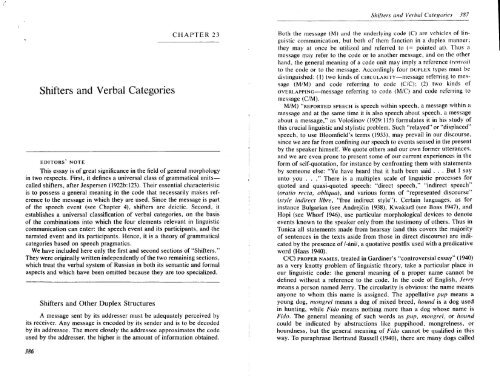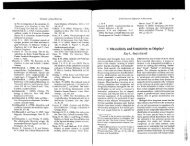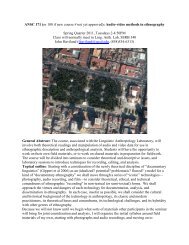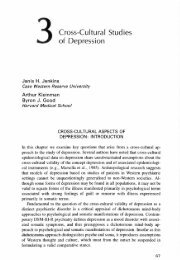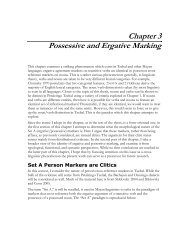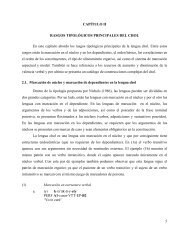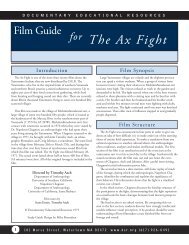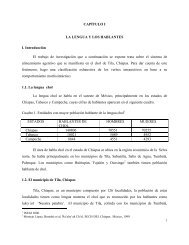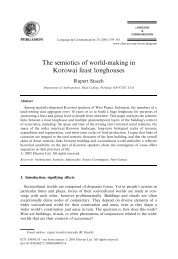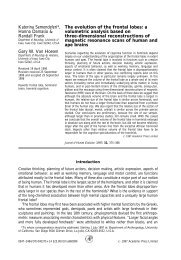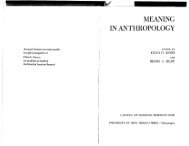Shifters and Verbal Categories
Shifters and Verbal Categories
Shifters and Verbal Categories
Create successful ePaper yourself
Turn your PDF publications into a flip-book with our unique Google optimized e-Paper software.
<strong>Shifters</strong> <strong>and</strong> <strong>Verbal</strong> <strong>Categories</strong><br />
EDITORS' NOTE<br />
CHAPTER 23<br />
This essay is of great significance in the field of general morphology<br />
in two respects. First, it defines a universal class of grammatical units-<br />
called shifters, after Jespersen (1922b: 123). Their essential characteristic<br />
is to possess a general meaning in the code that necessarily makes ref-<br />
erence to the message in which they are used. Since the message is part<br />
of the speech event (see Chapter 4), shifters are deictic. Second, it<br />
establishes a universal classification of verbal categories, on the basis<br />
of the combinations into which the four elements relevant in linguistic<br />
communication can enter: the speech event <strong>and</strong> its participants, <strong>and</strong> the<br />
narrated event <strong>and</strong> its participants. Hence, it is a theory of g~ammatical<br />
categories based on speech pragmatics.<br />
We have included here only the first <strong>and</strong> second sections of "<strong>Shifters</strong>."<br />
They were originally written independently of the two remaining sections,<br />
which treat the verbal system of Russian in both its semantic <strong>and</strong> formal<br />
aspects <strong>and</strong> which have been omitted because they are too specialized.<br />
<strong>Shifters</strong> <strong>and</strong> Other Duplex Structures<br />
A message sent by its addresser must be adequately perceived by<br />
its receiver. Any message is encoded by its sender <strong>and</strong> is to be decoded<br />
by its addressee. The more closely the addressee approximates the code<br />
used by the addresser, the higher is the amount of information obtained.<br />
386<br />
ShiJiers <strong>and</strong> <strong>Verbal</strong> Cnregories 387<br />
Both the message (M) <strong>and</strong> the underlying code (C) are vehicles of linguistic<br />
communication, but both of them function in a duplex manner:<br />
they may at once be utilized <strong>and</strong> referred to (= pointed at). Thus a<br />
message may refer to the code or to another message, <strong>and</strong> on the other<br />
h<strong>and</strong>, the general meaning of a code unit may imply a reference (ren~wi)<br />
to the code or to the message. Accordingly four DUPLEX types must be<br />
distinguished: ( I) two kinds of CIRCULARITY-message referring to message<br />
(MIM) <strong>and</strong> code referring to code (CIC); (2) two kinds of<br />
OVERLAPPING-message referring to code (MIC) <strong>and</strong> code referring to<br />
message (CIM).<br />
M/M) "REPORTED SPEECH is speech within speech, a message within a<br />
message <strong>and</strong> at the same time it is also speech about speech, a message<br />
about a message," as Voloiinov (1929:115) formulates it in his study of<br />
this crucial linguistic <strong>and</strong> stylistic problem. Such "relayed" or "displaced"<br />
speech, to use Bloomfield's terms (1933), may prevail in our discourse,<br />
since we are far from confining our speech to events sensed in the present<br />
by the speaker himself. We quote others <strong>and</strong> our own former utterances.<br />
<strong>and</strong> we are even prone to present some of our current experiences in the<br />
form of self-quotation, for instance by confronting them with statements<br />
by someone else: "Ye have heard that it hath been said . . . But I say<br />
unto you . . ." There is a multiplex scale of linguistic processes for<br />
quoted <strong>and</strong> quasi-quoted speech: "direct speech," "indirect speech"<br />
(oratio recta, obliqua), <strong>and</strong> various forms of "represented discourse"<br />
(style indirect libre, "free indirect style"). Certain languages, as for<br />
instance Bulgarian (see AndrejEin 1938), Kwakiutl (see Boas 1947), <strong>and</strong><br />
Hopi (see Whorf 1946), use particular morphological devices to denote<br />
events known to the speaker only from the testimony of others. Thus in<br />
Tunica all statements made from hearsay (<strong>and</strong> this covers the majority<br />
of sentences in the texts aside from those in direct discourse) are indicated<br />
by the presence of 1-&nil, a quotative postfix used with a predicative<br />
word (Haas 1940).<br />
CIC) PROPER NAMES, treated in Gardiner's "controversial essay" (1940)<br />
as a very knotty problem of linguistic theory, take a particular place in<br />
our linguistic code: the general meaning of a proper name cannot be<br />
defined without a reference to the code. In the code of English, Jerry<br />
means a person named Jerry. The circularity is obvious: the name means<br />
anyone to whom this name is assigned. The appellative pup means a<br />
young dog, mongrel means a dog of mixed breed, hound is a dog used<br />
in hunting, while Fido means nothing more than a dog whose name is<br />
Fido. The general meaning of such words as pup, mongrel, or hound<br />
could be indicated by abstractions like puppihood, mongrelness, or<br />
houndness, but the general meaning of Fido cannot be qualified in this<br />
way. To paraphrase Bertr<strong>and</strong> Russell (1940), there are many dogs called
388 MEANING IN LANGUAGE: GRAMMATICAL AND LEXICA1 Shifirrs <strong>and</strong> Vrrhal Cate,qories 389<br />
Fido, but they do not share any property of "Fidone\s." Also thc indefinite<br />
pronoun corresponding to names such as Jean. Jan, Joan. Junethe<br />
"what's-her-name" or "what-do-you-call-her" or "how-d'ye-callherw-includes<br />
a patent reference to the code.<br />
MIC) A message referring to the code is in logic termed an AUTONY-<br />
MOUS mode of speech.' When we say, The pup is u ~c*insome anitncrl or<br />
The pup is rvhlmpering, the word pup designates a young dog, whereas<br />
in such sentences as "Pup" is a nom which means ci young dog or. more<br />
briefly, "Pup" means a young dog or "Pup" is u monosyllable, the word<br />
pup-one may state with Carnap (1937)-is used as its own designation.<br />
Any elucidating interpretation of words <strong>and</strong> sentences-whether intralingual<br />
(circumlocutions, synonyms) or interlingual (translation)-is a<br />
message referring to the code. Such a hypostasis-as Bloomfield<br />
(1933: 148) pointed out-"is closely related to quotation, the repetition of<br />
speech," <strong>and</strong> it plays a vital role in the acquisition <strong>and</strong> use of language.<br />
CIM) Any linguistic code contains a particular class of grammatical<br />
units which Jespersen (1922b) labeled SHIFTERS: the general meaning of<br />
a shifter cannot be defined without a reference to the message.<br />
Their semiotic nature was discussed by Burks (1949) in his study on<br />
Peirce's classification of signs into symbols, indices, <strong>and</strong> icons.<br />
According to Peirce, a symbol (for example the English word red) is<br />
associated with the represented object by a conventional rule, while an<br />
index (such as the act of pointing) is in existential relation with the object<br />
it represents. <strong>Shifters</strong> combine both functions <strong>and</strong> belong therefore to<br />
the class of INDEXICAL SYMBOLS. AS a striking example Burks cites the<br />
personal pronoun. I means the person uttering I. Thus on one h<strong>and</strong>, the<br />
sign I cannot represent its object without being associated with the latter<br />
"by a conventional rule," <strong>and</strong> in different codes the same meaning is<br />
assigned to different sequences such as I, ego, ich, <strong>and</strong> ja: consequently<br />
I is a symbol. On the other h<strong>and</strong>, the sign I cannot represent its object<br />
without "being in existential relation" with this object: the word I des-<br />
ignating the utterer is existentially related to his utterance <strong>and</strong> hence<br />
functions as an index (see Benveniste 1956).<br />
The peculiarity of the personal pronoun <strong>and</strong> other shifters was often<br />
believed to consist in the lack of a single, constant, general meaning.<br />
Husserl (1913): "The word 'I' designates a different person in each case<br />
<strong>and</strong> it does this always by means of a new meaning." For this alleged<br />
multiplicity of contextual meanings, shifters in contradistinction to sym-<br />
bols were treated as mere indices (Buhler 1934). Every shifter, however,<br />
possesses its own general meaning. Thus I means the addresser (<strong>and</strong><br />
you, the addressee) of the message to which it belongs. For Bertr<strong>and</strong><br />
Russell, shifters, or in his terms "egocentric particulars," are defined by<br />
the fact that they never apply to more than one thing at a time. This.<br />
hpwever, is common to all the syncategorematic terms For example the<br />
con.iunction twt each time expresses ;in adversative relation between two<br />
stated concepts <strong>and</strong> not the generic idea of contrariety. In fact, shifters<br />
are distinguished from all other constituents of the linguistic code solely<br />
by their compulsory reference to the given message.<br />
The indexical symbols. <strong>and</strong> in particular the personal pronouns. which<br />
the Humboldtian tradition conceives of as the most elementary <strong>and</strong> primitive<br />
stratum of language, are. on the contrary. a complex category where<br />
code <strong>and</strong> message overl;rp. Therefore pronouns belong to the late acquisitions<br />
in child language <strong>and</strong> to the early losses in aphasia. If we observe<br />
that even linguistic scientists had difficulties in defining the general<br />
meaning of the term i (or you), which signifies the same intermittent<br />
function of different subjects, it is quite obvious that the child who has<br />
learned to identify himself with his proper name will not easily become<br />
accustomed to such alienable terms as the personal pronouns: he may<br />
be afraid of speaking of himself in the first person while being called yo11<br />
by his interlocutors. Sometimes he attempts to redistribute these appellations.<br />
For instance, he tries to monopolize the first person pronoun:<br />
"Don't dare call yourself I. Only I am I, <strong>and</strong> you are only you." Or he<br />
uses indiscriminately either I or you both for the addresser <strong>and</strong> the<br />
addressee so that this pronoun means any participant of the given dialogue.<br />
Or finally I is so rigorously substituted by the child for his proper<br />
name that he readily names any person of his surroundings but stubbornly<br />
refuses to utter his own name: the name has for its little bearer only a<br />
vocative meaning, opposed to the nominative functiqn of I. This attitude<br />
may persevere as an infantile survival. Thus Guy de Maupassant confessed<br />
that his name sounded quite strange to him when pronounced by<br />
himself. The refusal to utter one's own name may become a social<br />
custom. Zelenin (1930) notes that in the Samoyed society the name was<br />
taboo for its carrier.<br />
Jim told me "Jicksks" tneans "movies." This brief utterance includes all<br />
four types of duplex structures: reported speech (MIM), the autonymous<br />
form of speech (MIC), a proper name (CIC), <strong>and</strong> shifters (CIM), namely<br />
the first-person pronoun <strong>and</strong> the preterit, signaling an event prior to the<br />
delivery of the message. In language <strong>and</strong> in the use of language, duplicity<br />
plays a cardinal role. In particular, the classification of grammatical, <strong>and</strong><br />
especially verbal, categories requires a consistent discrimination of<br />
shifters.<br />
Attempt to Classify. <strong>Verbal</strong> <strong>Categories</strong><br />
In order to classify the verbal categories two basic distinctions are<br />
to be observed:
390 MEANING IN LANGUAGE: GRAMMATICAL AND LEXICAL.<br />
1. speech itself (0, <strong>and</strong> its topic, the narrated matter (");<br />
2. the event itself (E). <strong>and</strong> any of its participants (P), whether<br />
"performer" or "undergoer."<br />
Consequently four items are to be distinguished: a narrated event (En),<br />
a speech event (Es), a participant of the narrated event (Pn), <strong>and</strong> a<br />
participant of the speech event (P'), whether addresser or addressee.<br />
Any verb is concerned with a narrated event. <strong>Verbal</strong> categories may<br />
be subdivided into those which do <strong>and</strong> those which do not involve the<br />
participants of the event. <strong>Categories</strong> involving the participants may characterize<br />
either the participants themselves (Pn) or their relation to the<br />
narrated event (PnEn). <strong>Categories</strong> abstracting from the participants characterize<br />
either the narrated event itself (En) or its relation to another<br />
narrated event (EnEn). For categories characterizing only one narrated<br />
item-either the event (En) itself or its participants (Pn) themselves-the<br />
term DESIGNATORS will be used, while those categories which characterize<br />
a narrated item (En or Pn) with respect to another narrated item<br />
(EnEn or PnEn) will be termed CONNECTORS. I<br />
Designators indicate either the quality or the quantity of the narrated<br />
item <strong>and</strong> may be termed QUALIFIERS <strong>and</strong> QUANTIFIERS respectively.<br />
Both designators <strong>and</strong> connectors may characterize the narrated event<br />
(procPs de I'e'nonce') <strong>and</strong>/or its participants either without or with reference<br />
to the speech event (proces de l'e'nonciation) (.../Es) or its participants<br />
(...IPS). <strong>Categories</strong> implying such a reference are to be termed<br />
SHIFTERS; those without such a reference are NONSHIFTERS.<br />
With regard to these basic dichotomies any generic verbal category<br />
can be defined.<br />
Pn) Among categories involving the participants of the narrated event,<br />
GENDER <strong>and</strong> NUMBER characterize the participants themselves without<br />
reference to the speech event-gender qualifies, <strong>and</strong> number quantifies<br />
the participants. In Algonquian, for example, verbal forms indicate<br />
whether the performer, on the one h<strong>and</strong>, <strong>and</strong> the undergoer, on the other,<br />
are animate or inanimate (Bloomfield 1946); <strong>and</strong> the singleness, duality,<br />
or multiplicity of performers as well as undergoers is expressed in Koryak<br />
conjugation (Bogoraz 1922).<br />
Pn/P" PERSON characterizes the participants of the narrated event with<br />
reference to the participants of the speech event. Thus first person signals<br />
the identity of a participant of the narrated event with the performer of<br />
the speech event, <strong>and</strong> the second person, the identity with the actual or<br />
potential undergoer of the speech event.<br />
En) STATUS <strong>and</strong> ASPECT characterize the narrated event itself without<br />
involving its participants <strong>and</strong> without reference to the speech event.<br />
Status (in Whorf's terminology) defines the logical quality of the event.<br />
<strong>Shifters</strong> crrrd <strong>Verbal</strong> <strong>Categories</strong> 391<br />
For example in Gilyak, the affirmative, presumptive. negative. interrog-<br />
ative, <strong>and</strong> negative-interrogative statuses are expressed by special verbal<br />
forms (Krejnovii: 1934). In English the assertive status uses the "do"-<br />
combinations which in certain conditions are optional for an affir-<br />
mative assertion but compulsory for a negative or questioned assertion.<br />
Aspect quantifies the narrated event.<br />
EnE" TENSE characterizes the narrated event with reference to the<br />
speech event. Thus the preterit informs us that the narrated event is<br />
anterior to the speech event.<br />
YEn) VOICE characterizes the relation between the narrated event <strong>and</strong><br />
its participants without reference to the speech event or to the speaker.<br />
PnEn/P" MOOD characterizes the relation between the narrated event<br />
<strong>and</strong> its participants with reference to the participants of the speech event:<br />
in Vinogradov's formulation, this category "reflects the speaker's view<br />
of the character of the connection between the action <strong>and</strong> the actor or<br />
the goal" (1947).<br />
EnEn) There is no st<strong>and</strong>ardized name for this category; such labels as<br />
"relative tense" cover only one of its varieties. Bloomfield's (1946) term<br />
"order" or rather its Greek model "taxis" seems to be the most appro-<br />
priate. TAXIS characterizes the narrated event in relation to another nar-<br />
rated event <strong>and</strong> without reference to the speech event, thus Gilyak dis-<br />
tinguishes three kinds of independent taxis-one requires, one admits,<br />
<strong>and</strong> one excludes a dependent taxis, <strong>and</strong> the dependent taxes express<br />
various relationships with the independent verb-simultaneity, ante-<br />
Table 23.1 <strong>Verbal</strong> categories<br />
Reference Participant involved<br />
to narrated<br />
item Designator Connector<br />
Nonshifter Qualifier: Gender, Voice<br />
Quantifier: Number<br />
Shifter Person Mood<br />
Table 23.2 <strong>Shifters</strong> <strong>and</strong> nonshifters<br />
--<br />
Participant not involved<br />
Designator Connector<br />
Qualifier: Status, Taxis<br />
Quantifier: Aspect<br />
Tense Evidential<br />
Reference to<br />
Participant involved Participant not involved<br />
narrated item Designator Connector Designator Connector<br />
Nonshifter Pn PnEn En EnEn<br />
Shifter PnIPs PnEn/Ps EnIEs EnEns/Es
iority, interruption, concessive connection, etc. A similar Hopi pattern<br />
is described by Whorf.<br />
EnEnVEs) EVIDENTIAL is a tentative label for the verbal category which<br />
takes into account three events-a narrated event, a speech event, <strong>and</strong><br />
a narrated speech event (En'), namely the alleged source of information<br />
about the narrated event. The speaker reports an event on the basis of<br />
someone else's report (quotative, i.e. hearsay evidence), of a dreani<br />
(revelative evidence), of a guess (presumptive evidence), or of his own<br />
previous experience (memory evidence). Bulgarian conjugation dis-<br />
tinguishes two semantically opposite sets of forms: "direct narration"<br />
(Ens = ES) versus "indirect narration" (En" Es). To our question, what<br />
happened to the steamer Etpdokija, a Bulgarian first answered, zcltrlincila<br />
(it is claimed to have sailed), <strong>and</strong> then added, zarnina (I bear witness; it<br />
sailed). (Cf. H. G. Lunt [I9521 on the systematic distinction made in the<br />
Macedonian verbal pattern between "vouched for" <strong>and</strong> "distanced"<br />
events.)<br />
The interrelation of all these generic categories may be illustrated by<br />
the overall scheme in Table 23.1. With special regard to the opposition<br />
shifters versus nonshifters, we condense this model into the simpler<br />
format appearing in Table 23.2.<br />
Sound <strong>and</strong> Meaning<br />
in Language:<br />
Their Interrelations


